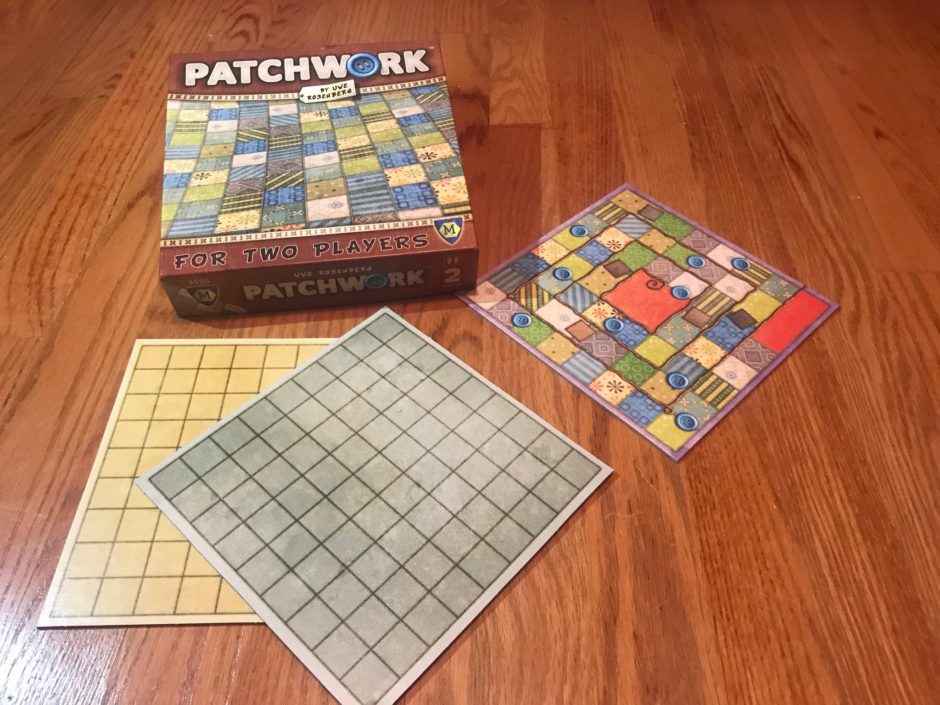If you’re looking to get your crafty loved one away from their needles, hook, machine, etc. for the night, Patchwork may be the best way to do it. Hiding behind a seemingly mundane theme is actually a really compelling game, and has been recognized with numerous awards. While it was released in 2014, it’s small, unassuming box is easy to miss in the game store. But make no mistake: this game holds up after all these years and is still a game you should check out.

Patchwork, created by Uwe Rosenberg, is a 2-player game featuring adorable polynomial fabric patches used to collect and create a beautiful patch with buttons as the currency. Each player starts with an empty board and a set amount of buttons to “purchase” new fabric strips, and the first person to either finish their board or have the most buttons at the end, wins. While people don’t typically use buttons in patchwork quilting, we’ll forgive this anachronism for the sake of the game.

Seems pretty simple right? The strategy required to play this game can bring many crafters and Tetris lovers together in a fun time. Each game consistently takes about 30 minutes to complete, but you’ll quickly find yourself in need of playing again and again in order to see who can create the best patchwork quilt and acquire the most buttons. In playing the game more than 20 times since receiving it as a birthday present (from the loving spouse of a hopeless knitting addict), I can confidently say it never gets boring or repetitive. Plus, there’s nothing more fun or satisfying than a cozy night playing board games and laughing with someone you love.
So how do you win? Be the first person to complete your board in totality (a virtual impossibility) or be the player with the most buttons when you run out of spaces on the game board. Be aware: The open spaces on your board subtract from the buttons you have!
Here’s ultimately what makes Patchwork so enjoyable:
- You get a limited amount of patches to choose from: You may only choose from the upcoming THREE patches within the grouping of patches, which are circled around the board. If you can’t purchase the next three patches, simply move your chesspiece on the board to pass your opponent and collect the buttons equal to your move.
- Each time you approach a button on the board, you collect more buttons, thus compounding your currency.
- Use strategy and be the first to get a one-square leather patch to complete a particularly tricky location on your board. These patches are the goal of the game for some people if you’re using a lot of large or awkward pieces. Get a patch and fill in the holes so your board is completed faster.
What strategies can you use to win Patchwork? While you can play the game in any strategy you can, the players in my household have taken to the following three strategies:
- Fill the board the most so you can’t be beat! If you fill a 7×7 square on the board, you’ll win an extra set of buttons, which just might tip you over to the winning side.
- Collect ALL the buttons! some of the game pieces have multiple buttons available when you purchase them. Whenever you pass a button the board, you collect buttons equal to those on the pieces. When you have 20 buttons on your board, you become very rich very fast. Be aware though: These pieces can be expensive.
- Get (or steal, if you’re me) the leather patches: This strategy can push the game a little too quickly, but if you get the leather patches first, you stand a chance to be a little more aggressive with your patch purchases and fill in the gaps on your board. Go ahead, buy the H piece! You can get the single patch and fix it later.

Patchwork is fun for those of all ages and is even a great game for kids to understand spacial awareness and shapes on top of counting.
What game has a theme that seems mundane but is a great deal of fun? Tell us in the comments!
More Gaming Goodness!
- Gaming on the Air: 5 Board Game Podcasts You Should Be Listening To
- Build A Gorgeous Mosaic Fit for a King On Your Tabletop in Azul
- The Best In Tabletop: Making Stained Glass Windows In Sagrada
Photo Credit: Amanda Hansen